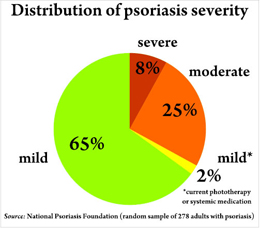The recommended treatment for psoriasis depends on several factors, including the type, location and severity of psoriasis .
.
Psoriasis severity may be measured by amount of skin affected by psoriasis. This is described as the percentage of body surface area (BSA). The area beneath one hand, including fingers and thumb, is equal to 1% of your BSA. If the skin affected by psoriasis is roughly equal to the area beneath 2 hands, then about 2 percent of the body is affected.
- Mild psoriasis affects less than 3% of the body.
- Moderate psoriasis affects 3 to 10% of the body.
- Severe psoriasis affects more than 10% of the body.
Of those with psoriasis, 65% of people have mild psoriasis, 25% have moderate psoriasis, and 8% have several psoriasis.
However, relying on body surface area alone does not capture other important factors.
Psoriasis severity is also influenced by the type of psoriasis, the impact the illness has on a person's quality of life, and a person's susceptibility to side effects from treatment.
For instance, psoriasis is generally considered severe if it covers the palms and soles because of its impact on a person's ability to walk and perform day-to-day tasks.
Medical researchers that perform clinical studies of psoriasis use a severity measurement called the Psoriasis Area Severity Index (PASI). This is a widely used standard that may appear in medical literature or on information about psoriasis medications, but is too complex for routine use in the clinic.
Source: Vivacare
Last updated : 1/8/2019